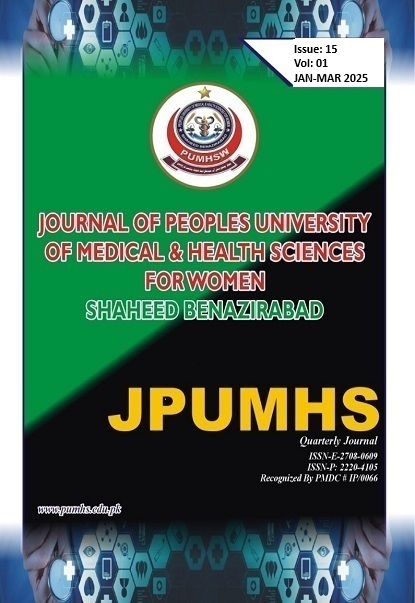ORIGINAL ARTICLECOMPARISON OF MEAN HEALING TIME WITH HONEY VERSUS 1% ACETIC ACID IN THE TREATMENT OF INFECTED WOUNDS
JPUMHS; 2025:15:01,85-91. http://doi.org/10.46536/jpumhs/2025/15.01.600
Keywords:
Honey (Locally available), Acetic Acid, Healing, Infected Wounds, TimeAbstract
BACKGROUND: Infected wounds pose a significant challenge in medical practice,
requiring effective treatment strategies to facilitate timely healing. The use of topical solutions
is a common approach for wound management. The antimicrobial properties of honey
compare with 1% acetic acid make it an attractive option for treating infected wounds. Honey
creates an acidic environment that decrease the bacterial growth of bacteria, also MRSA
Methicillin-resistant Staphylococcus aureus and commonly Pseudomonas aeruginosa, can
happen due to wound infections. OBJECTIVE: To compare mean healing time with honey
versus 1% acetic acid in the infected wound treatment. PLACE AND DURATION OF
STUDY: This is a Randomized Control Trial Study was done on patients in the Department
of general surgery, Liaquat University of Medical & Health Sciences Hospital Jamshoro, for
the period of one and half year July 2022 to March 2023. PATIENTS AND METHOD: All
patients who fulfilled the inclusion criteria and visited LUMHS, Jamshoro were included in
the study. Informed consent was taken after explaining the procedure, risks and benefits of the
study. The sample was divided into two groups (intervention and control). For the intervention
group, honey available commercially was used for cleaning and debriding the wound and
placed on the wound via soaked gauze. The dressing was done twice daily. The same was
done for the control group using obtained 1% acetic acid. All the collected data were entered
into the proforma attached at the end and used electronically for research purposes. Total 440
cases with clinical diagnosis of infected wound were admitted through outpatient department.
All the data was recorded on predesigned Performa. RESULTS: The mean ± standard
deviation of age in group A (Honey locally available) was 41.10±12.95 and group B (1%
acetic acid) was 43.65±13.62 years. In the group-wise distribution of gender, 146 (66.4%)
males and 74 (33.6%) females have included in group A while 166 (75.5%) males and 54
(24.5%) females were included in group B respectively. The mean ± SD for the duration of
healing time was noted as 5.31±3.50 and 13.68±7.64 days in group A and group B respectively
while having a highly significant P-value i.e. (0.0001) CONCLUSION: It is to be found that
the healing time of infected wounds with honey is significantly less as compared to 1% acetic
acid. More well-controlled prospective randomized trials with bigger sample size, with more
parameters in large centers in Pakistan are
Downloads
Downloads
Published
How to Cite
Issue
Section
License

This work is licensed under a Creative Commons Attribution-NoDerivatives 4.0 International License.




